Last Chance to Catch NYC's Holiday Notalgia Train
We met the voices of the NYC subway on our nostalgia ride this weekend!


When thinking about the American Revolutionary War, most may jump to the Battles of Saratoga, Bunker Hill, or Trenton. Yet New York City was an incredibly important city during the war, the site of battles including Long Island, Fort Washington, and Harlem Heights, as well as other skirmishes and naval encounters. George Washington and his troops spent considerable amounts of time across the modern five boroughs, and New York City was an important strategic center for the Continental Army and the British. From Fraunces Tavern where the Sons of Liberty often met to Staten Island’s Conference House where the war almost ended before it began, check out these 11 Revolutionary War sites across the city.

The Battle of Golden Hill, which has largely been forgotten, was a clash between the Sons of Liberty and British soldiers on January 19, 1770, in the modern-day Financial District. The “battle” was one of the first violent incidents in the lead-up to the Revolutionary War, along with the Boston Massacre. The conflict stemmed from the demolition of a “Liberty pole” erected by the Sons of Liberty in City Hall Park, symbolizing their displeasure with British authorities. After a series of poles, which were all either removed or blown up, the Sons of Liberty had enough.
Isaac Sears, an American merchant, tried to stop soldiers from posting handbills at the Fly Market near Maiden Lane. After Sears captured some soldiers and marched them to the mayor’s office, they were surrounded by a crowd of locals, as well as additional British soldiers who unsuccessfully tried to rescue them. After an officer shouted, “Soldiers, draw your bayonets and cut your way through them,” the conflict became bloody, and some soldiers and townsfolk were injured.
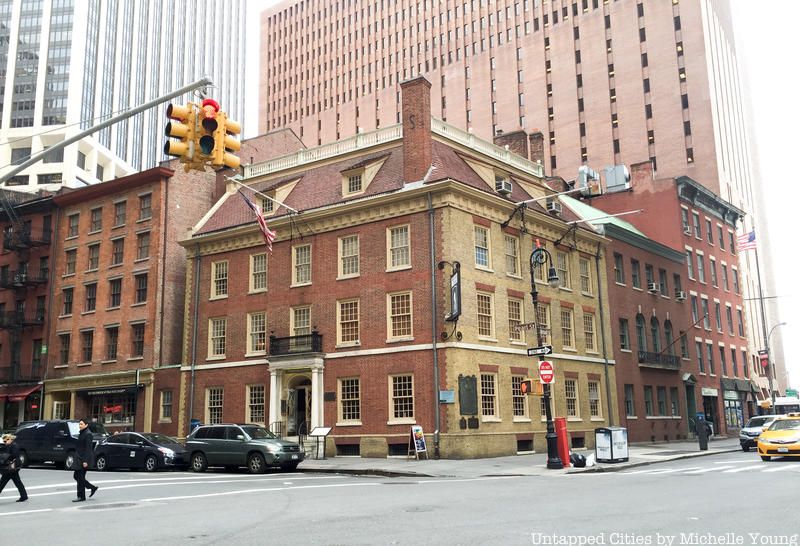
Fraunces Tavern, dating back to 1762, is considered the oldest restaurant in New York City, though there is some debate as to the actual age of the building itself. The brick home in the Financial District dates back to between 1719 and 1722, although its architecture has been renovated and reconstructed many times over the years. Before Samuel Fraunces opened the tavern, the building hosted a dance school and a trading firm.

Fraunces Tavern was one of the main meeting places of the Sons of Liberty, the planners of the Boston Tea Party. In August 1775, the British Royal Navy fired a cannonball through the roof of the building after a student militia from Kings College fired on the HMS Asia. The year after, the British captured the restaurant and forced the staff to feed their soldiers. “British-American Board of Inquiry” meetings were also held at the tavern, ensuring that no American property left with British troops. When the British were finally driven out on November 25th of 1783, General George Clinton held an honorary banquet there for George Washington, whose tooth is now on display in the upstairs museum.

At the site of Fort Tryon Park and Bennett Park in Hudson Heights was the Battle of Fort Washington during the American Revolution, fought on November 16, 1776. The British were victorious over the Patriots, who surrendered the garrison of Fort Washington in one of the worst American defeats of the war. A total of 59 Americans were killed during the battle, and another 2,837 were taken as prisoners of war. Fort Tryon takes its name from Sir William Tryon, the last British Governor of the Province of New York. American soldier Margaret Corbin was the first woman to fight in the war, and Fort Tryon Park’s southern entrance is named after her.
Under William Howe, British forces defeated the Continental Army under George Washington at the previous Battle of White Plains. This made Fort Washington the only American stronghold in Manhattan. Nathanael Greene was ordered to abandon the fort and remove its garrison, but the fort’s commander, Robert Magaw, refused since he believed it could be defended. Although the Harlem River’s tides slowed down the attack, Howe led an assault on three sides, and Magaw eventually surrendered.
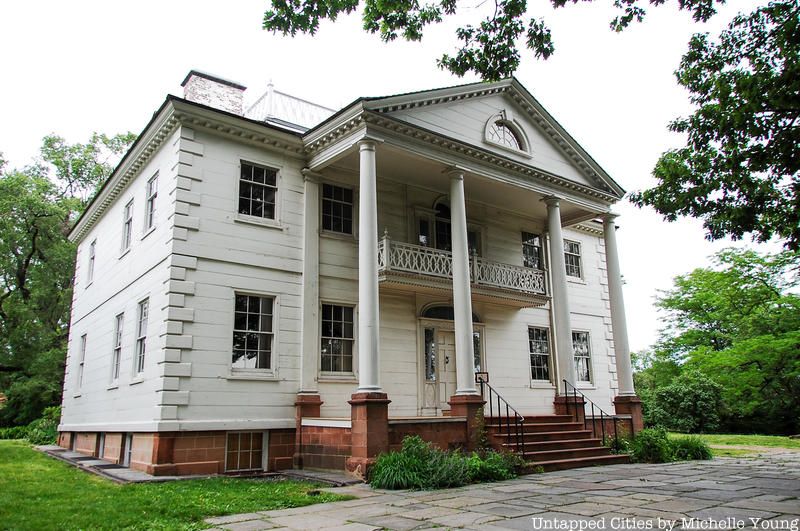
Perched atop a hill in Washington Heights, the Morris-Jumel Mansion is one of NYC’s most prominent Revolutionary War sites. It served first as a summer house for a wealthy British colonel, then as headquarters for troops during the American Revolution, then an inn for weary travelers. Constructed in 1765, the Morris-Jumel Mansion is the oldest residence in Manhattan, built as a summer house for British Colonel Roger Morris and his wife Mary Philipse. The mansion was originally called “Mount Morris” since it was situated on 135 acres at one of the island’s highest points.
When the American Revolution broke out in 1776, the Morrises departed, and George Washington and his Continental officers converted the home into their headquarters. Washington secured a victory during the Battle of Harlem Heights partially because of the home’s strategic location atop a high vantage point between the Hudson and Harlem Rivers. Shortly after, though, Washington and his troops retreated north to White Plains, after which the mansion was occupied by British and Hessian armies.
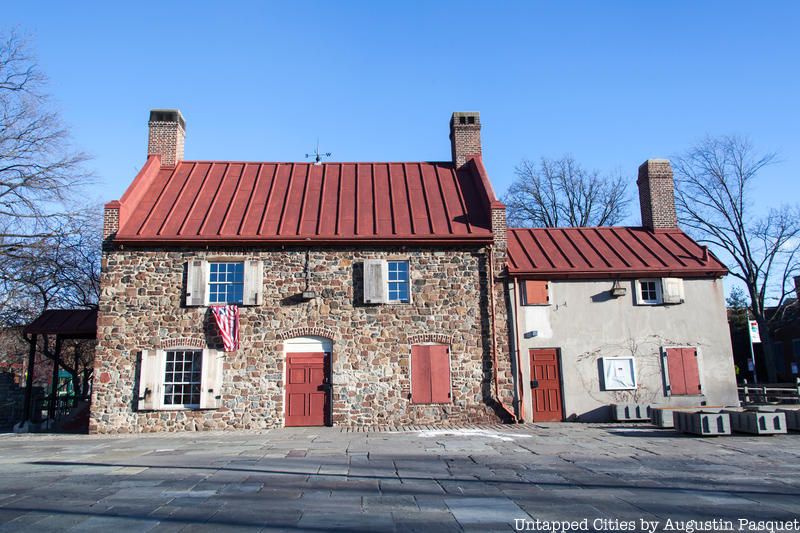
The Old Stone House is a 1933 replica of the Vechte-Cortelyou House, which was destroyed in 1897. The solid stone house was originally constructed in 1699 by Hendrick Claessen Vechte, who harvested oysters in Gowanus Creek and ferried the family’s produce to lower Manhattan. The home served as a significant location during the Battle of Long Island, the largest battle of the American Revolution.
On August 27th, 1776, American General William Alexander led a regiment of 400 Maryland soldiers against 2,000 British troops, who were fighting from their stronghold at the Old Stone House. Most of the Maryland 400 lost their lives that day, and some men who tried to cross the marsh were bogged down and eventually captured. The soldiers were buried in a mass grave on what is today 3rd Avenue between 7th and 8th Streets. The Old Stone House, located in Washington Park, was reconstructed using stones from the original site and remains one of NYC’s most important Revolutionary War sites.
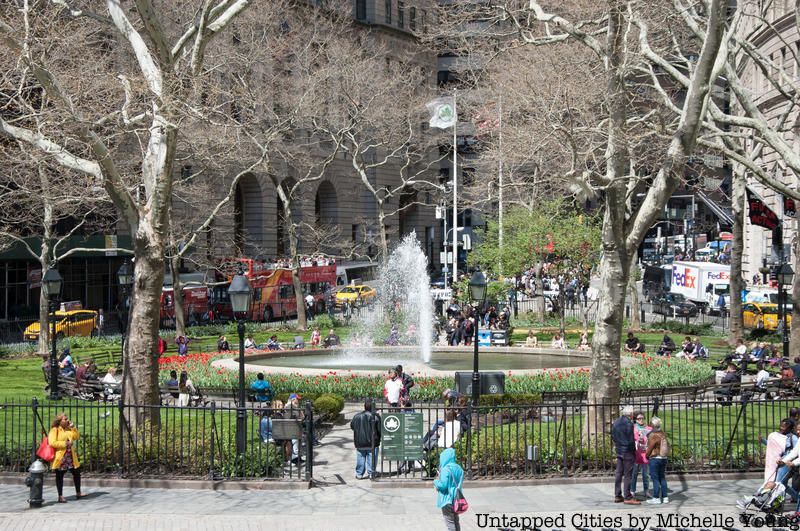
Bowling Green is the oldest public park in New York City, designated in 1733, and it included an actual bowling green prior to the Revolutionary War. The park also contained an equestrian statue of George III dressed in Roman attire and commissioned by the British government. Many protests in opposition to British laws and taxes took place by the statue, and an iron fence was built around the park to protect the statue from vandalism, making it the oldest fence in the city.
On July 9, 1776, the Sons of Liberty toppled the statue after the Declaration of Independence was read to troops at City Hall. According to legend, the statue was chopped up and shipped to a Connecticut foundry. The statue’s head was perhaps paraded on a pike-staff. The statue was not the only controversial object in the park; on November 25, 1783, a U.S. soldier ripped down the British flag at Bowling Green and replaced it with the American flag.
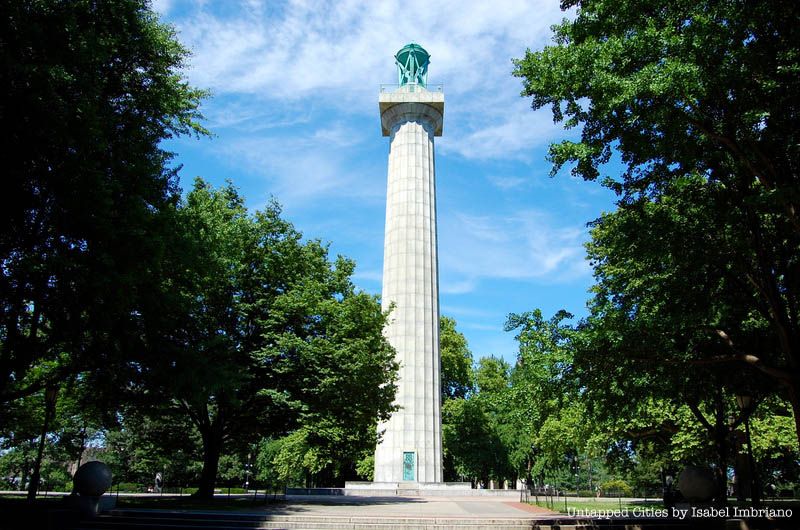
Fort Greene Park is one of the city’s oldest parks, dating back to the Revolutionary War. The park includes parts of the high ground where the Continental Army constructed fortifications before the Battle of Long Island. General Nathanael Greene supervised the construction of the park, which contained Fort Putnam, named after Washington’s Chief of Engineers.
Fort Greene Park today contains the Prison Ship Martyrs’ Monument, in honor of the 11,500 prisoners who died from disease and malnutrition aboard prison ships in nearby Wallabout Bay. These men and women were captured following the Continental Army’s retreat at the Battle of Long Island. Many of the dead were thrown overboard, and many remains were more properly buried during the construction of the Brooklyn Navy Yard.

Overlooking the Arthur Kill River and Raritan Bay, the Conference House is located on the southernmost tip of Staten Island. The house was originally part of a 1,630-acre property owned by British naval captain Christopher Billopp, who according to legend won Staten Island for the state of New York by winning a bet that he could sail around the island in a day. The Conference House is named after the 1776 Staten Island Peace Conference in which John Adams, Edward Rutledge and Benjamin Franklin met with British Admiral Lord Richard Howe to discuss the possibility of ending the war. No agreement was made after the Patriots refused.
Other Revolutionary War sites on Staten Island include Historic Richmond Town, where British troops were stationed during the war. Historic Richmond Town consists of over 30 buildings and sites dating between the late 17th and early 20th centuries, and some of the structures used during the Revolutionary War still stand. There was also a Battle of Staten Island in 1777 that was a failed Continental Army raid against British forces, suffering from a shortage of boats under the command of John Sullivan.

The Van Cortlandt House in Van Cortlandt Park in the Bronx is one of the borough’s most significant remaining Revolutionary War sites. The Georgian-style home had a strategic location between Broadway and Albany Post Road. Both Colonial and British armies stayed at the home and plantation, including George Washington and William Howe.
Augustus Van Cortlandt, who was a city clerk, hid city records from the British in Vault Hill. French generals who assisted the Americans in the war, including the Comte de Rochambeau and the Marquis de Lafayette, also stayed at the home for short periods.

The Battle of Harlem Heights, which took place in September 1776, occurred at the site of present-day Columbia University and Riverside Park. The battle was a turning point in the Revolutionary War following difficult Patriot losses at the Battle of Long Island and Landing at Kips Bay. American and British troops skirmished at today’s 106th Street and Broadway, and fighting was documented to have extended northwards to 125th Street.
Most of the fighting, though, took place around 120th Street and Riverside Drive, which is today the northern end of the main Columbia campus near Teachers’ College. A plaque on Columbia’s Math Building marks the site of the battle in which the Americans successfully pushed the British back to 106th Street after they advanced north. Although around 30 Americans were killed, the battle was a moral victory for the troops under Washington, Greene, and Thomas Knowlton. George Washington noted of this maneuver, “This little advantage has inspired our troops prodigiously. They find it only requires resolution and good officers to make an enemy give way.”

Governors Island played a significant role throughout the American Revolution, used as a military installation with many defensive forts. During the earlier French and Indian War, the island was used as a military encampment under Sir William Pepperell. Under George Washington, General Charles Lee was assigned with creating New York’s defensive plan, which included forts on Governors Island. General Israel Putnam added 40 cannons and earthworks to the island, and defensive structures continued to develop throughout the war.
These cannons were instrumental in dissuading British naval forces from traveling up the East River after a skirmish with the HMS Phoenix and HMS Rose. Washington’s retreat from Brooklyn to Manhattan following the Battle of Long Island was aided by the island’s fortifications. The island was later held by the British for a few years, Off of Governors island was the first documented submarine attack in history, in which the Americans unsuccessfully tried to detonate the Turtle.
Next, check out the Top 10 Secrets of the Morris-Jumel Mansion!
Subscribe to our newsletter